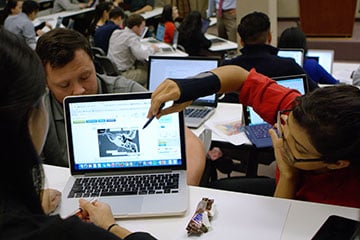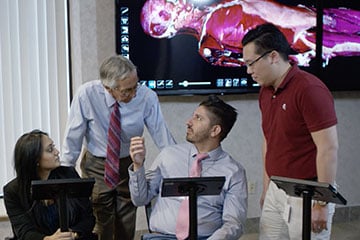 Dr. Hasel is the Associate Dean of the College of Dental Medicine at Western University of Health Sciences, a graduate health sciences school in Pomona, California. He has been using Realizeit to teach anatomy to his dental students since the fall of 2014, and is expanding adoption of the platform throughout the institution. He spoke to us about the way Realizeit helped him transform his classrooms—and begin fulfilling a long-held vision about how to engage 21st Century learners through the innovative use of technology.
Dr. Hasel is the Associate Dean of the College of Dental Medicine at Western University of Health Sciences, a graduate health sciences school in Pomona, California. He has been using Realizeit to teach anatomy to his dental students since the fall of 2014, and is expanding adoption of the platform throughout the institution. He spoke to us about the way Realizeit helped him transform his classrooms—and begin fulfilling a long-held vision about how to engage 21st Century learners through the innovative use of technology.
Q: You’ve had a vision about changing teaching and learning for a long time. What was it, and how did Realizeit fit in to making that a reality?
A: Working with Realizeit was inspired by a 12-year vision I had to build curriculum into a gaming-like learning environment. I watched how people, young and old, were consumed by video games— playing for hours, if not days, and never getting tired of it. I thought if we could build our educational programs into that kind of environment, students would choose learning over playing video games, because it would be equally engaging and fun.
Compare that to the big-box model of an instructor standing in front of a lecture hall reading out loud to students, and there’s no contest. I wanted to bring learning back to basic human nature, one that is self-directed, engaging and fun.
A decade ago, the technology wasn’t available unless you wanted to go into the gaming industry and had two or three million dollars to get the software written for you. But in 2013, I was walking the aisles at Educause with the specific mission of finding a platform we could build our courses on. I talked to all the big players, like Microsoft and Adobe, and wasn’t getting anywhere.
Then I passed a banner with the word “engine” on it, and began a conversation with one of Realizeit’s co-founders. We started talking about artificial intelligence and course mapping, and the rest is history.
Q: What was the problem you were trying to solve by implementing Realizeit?
 A: The problem was one of retention of knowledge, measuring knowledge proficiency, and ensuring that our students had mastered the subject matter in a way that could help their future patients. The lecture hall method of teaching is sufficient to prepare students to memorize and pass an exam, but we’re not training people just to pass an exam.
A: The problem was one of retention of knowledge, measuring knowledge proficiency, and ensuring that our students had mastered the subject matter in a way that could help their future patients. The lecture hall method of teaching is sufficient to prepare students to memorize and pass an exam, but we’re not training people just to pass an exam.
What we’re doing at Western University is educating competent doctors. We want them to have a functional knowledge of clinical anatomy that they’ll be using every day on every patient. I recently had a student who’s at the end of her second year getting ready for her national boards say to me, “I can’t believe how much anatomy I still know and understand.”
I would wager that a traditionally-educated student wouldn’t even remember five per cent of what they’d been taught—they’d have to go back to their flashcards and long lists of terminology. They don’t have a functional knowledge of the material the way that our students do when they learn like this.
Q: Why have you stayed with Realizeit after the initial pilot course?
A: Number one, we were able to build that engaging, self-motivational, learning environment. Students are enjoying the new environment, with its peer-to-peer, small-group learning and flipped classroom. It allows the faculty to engage, monitor, and mentor students rather than standing up in front of a big box and reading them “bedtime stories”.
Plus, there are the improvements in learning outcomes. We saw a 15-point increase in class averages on tests the first year, which is incredibly significant—explosive, in fact.
We were so excited about the early success that we quickly began thinking how do we expand this? We were confident in the Realizeit engine and began to learn more ways to leverage it. We’re building problem-based learning cases now, taking the most challenging graduate medical curriculum you can imagine and delivering it with great success in this new learning environment.
Q: Describe your classes before and after implementing Realizeit.
 A: Before, we taught in a large lecture hall with several hundred students, locked in a room for four hours. The students would sit there and have PowerPoint slides jammed down their throats—sometimes as many as 400 slides over the course of a lecture. It was 100% passive learning: listen, take notes, and memorize the material for an exam.
A: Before, we taught in a large lecture hall with several hundred students, locked in a room for four hours. The students would sit there and have PowerPoint slides jammed down their throats—sometimes as many as 400 slides over the course of a lecture. It was 100% passive learning: listen, take notes, and memorize the material for an exam.
Today, students come to class having already studied the learning materials for that day. The classes are still four hours, but now students are organized into small groups rotating through active learning stations where they collaborate on solving problems through various immersive and engaging activities. They’re applying a clinically functional knowledge of the anatomy and thinking critically, not just memorizing the names of different parts. The result is that they’re much more enthusiastic and excited about learning.
Q: Has this new approach to teaching and learning solved your big problem?
A: Yes, though I’m always striving to make the experience even more immersive and self-directed: a total video game-lke environment. I think we’re close to that, and we’ll be able to do that in the next two years with Realizeit and our other partners.
We still run a midterm and final exam, which isn’t really necessary as we can now measure their knowledge proficiency on a granular level constantly. Last year, we had a 100% pass rate on the anatomy section of the national board dental exams—that is with a cohort of about 75-100 students. In the recent past, many of our students really struggled to pass that section of the exam. A significant accomplishment.
Finally, when I talk with faculty who receive our anatomy students in upper-level courses like neuroscience or microbiology, they tell me that students who’ve learned anatomy this way really understand and have amazing functional knowledge of the subject, which accelerates and supports their learning of downstream subjects.
Q: What has been the reaction of the faculty?
A: During the first year, I would invite faculty to come and visit for half an hour, or to come and assist us in facilitating one of the learning activities. And without exception, 100 per cent of them walked away with their jaws dropped, saying “I can’t believe the level of student engagement; this is so exciting—let me know if I can continue to help.”
Soon, other faculty were approaching me within in the College of Dental Medicine, asking if they could put their courses on the Realizeit platform. I began talking to the third- and fourth-year faculty in the College of Medicine about building a pilot course for them, resulting in two other major courses within their first- and second-year curriculum.
When we work with faculty and get them involved with adaptive learning, they always come back to us and say two things: one, they see their whole course for the first time in a more complete way than they did before mapping it out. And second, that they’re excited to teach this way to students.
Q: Where do you go from here?
A: In the College of Dental Medicine, we are actively migrating entire curriculum to adaptive learning. That includes about 2,500 contact hours of material for 30-40 faculty. All the faculty are currently learning to teach with adaptive learning; they’re building their knowledge maps, and getting their content ingested into the system. We’ll be ready to go live with that later this year, and within two years, we will have the entire college curriculum on the adaptive learning platform.
Q: Do you feel that the level of investment and effort involved to make the change to adaptive learning is worth it?
A: Absolutely. I think it’s the nature of the beast to resist change. But if you compare the effort of properly maintaining a traditional course, it’s an equivalent amount of work to get an adaptive course up and running. And once you do, it’s actually easier to maintain the adaptive course – you can make instant changes in a way you can’t in the old format—when you are done with the edits, the whole course is immediately revisioned. At Western University, working with the Realizeit platform has profoundly changed our approach to teaching and learning for the better.
See how Western University has put Realizeit to work as part of its immersive adaptive learning environment in this video:
To learn more about how your institution can make adaptive and personalized learning a reality, contact us today for a demo!
